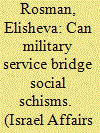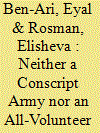|
|
|
Sort Order |
|
|
|
Items / Page
|
|
|
|
|
|
|
| Srl | Item |
| 1 |
ID:
171680


|
|
|
|
|
| Summary/Abstract |
Can the military bridge social schisms? Conventional wisdom supports this assumption. However, it seems that, at best, the effect of military service on bridging social schisms and promoting social cohesion is limited. This article examines the extended effect of contact hypothesis in the military, both in practice and as an element capable of bringing about a change in veterans’ thinking. It asks: are veterans who had diverse friendships during their service more likely to have diverse friendships in the future? If so, do they attribute their ability and willingness to include others within their ingroup to their military service? Based on findings from a study of Israeli college and university students, the article demonstrates that while indeed service friendships may be short lived, service alongside members of outgroups has certain longer-term effects and influences the social perception of veterans. Social messages can be both positive and negative and teach veterans the limits of redrawing social boundaries.
|
|
|
|
|
|
|
|
|
|
|
|
|
|
|
|
| 2 |
ID:
137041


|
|
|
|
|
| Summary/Abstract |
The image of the Israeli soldier has transmuted over time. This is particularly true when examining this image in Israeli media. As media reflects social changes, understanding the development of the image of the Israeli soldier in Israeli media may be indicative of wider transformations. During the 1982 Lebanon War the Israeli soldier was identified chiefly as a tough, masculine figure; a warrior. In the 1990s, there was a gradual transformation into a more vulnerable image: a scared, fragile survivor, who wants to return home in one piece. Conversely, during the first decade of the twenty-first century, the framing of the Israeli soldier becomes more complex, with both images present in the media. However, despite the fact both images appear, during this final period the ‘warrior’ image receives more visibility. Using theoretical literature from the fields of communications and civil–military–media relations, and covering two major Israeli news publications – Yediot Aharonot and Haaretz – this article traces the image of the Israeli soldier from the 1982 Lebanon War (1982) to Operation Cast Lead (2008–9).
|
|
|
|
|
|
|
|
|
|
|
|
|
|
|
|
| 3 |
ID:
185269


|
|
|
| 4 |
ID:
188794


|
|
|
|
|
| Summary/Abstract |
This article develops an analytical model of force composition that combines the advantages of conscription with those of an all-volunteer force. Using Israel as a hypothesis-generating case study, it argues that mandatory military service has undergone changes centered on five key organizing principles: selective conscription, early discharges, elongated lengths of service, forms of voluntary service and differing pay-scales, and other material and non-material incentives for conscripts. These principles are “grafted” onto conscription creating a hybrid, “volunteer-ized” model. The utility of the theoretical model lies in explaining how these principles facilitate mobilizing a needed number or recruits, providing an adequate level of military expertise, as well as maintaining the legitimacy of the armed forces by meeting domestic social, economic, and political expectations about its composition and the use of personnel at its disposal. The system is adaptive and flexible, as shown through the comparisons throughout the paper.
|
|
|
|
|
|
|
|
|
|
|
|
|
|
|
|
| 5 |
ID:
148251


|
|
|
|
|
| Summary/Abstract |
Military establishments view religious soldiers with mixed feelings and must contend with the specific dilemmas these soldiers present. This article suggests what might influence the managing of religious diversity in the ranks, using the idea of dimensions of isolation. The more removed a military is from society, the more likely it is to utilize internal mechanisms when dealing with religious soldiers. The less removed it is from society, the more likely it will be to turn to external mediating mechanisms in this regard. Using three dimensions of isolation (physical, temporal, and psychological), this article discusses the treatment of religious troops in the Israeli and Turkish cases. After exploring what can be learned from these cases regarding the accommodation of religious soldiers, the article concludes with some suggestions for future research.
|
|
|
|
|
|
|
|
|
|
|
|
|
|
|
|
|
|
|
|
|